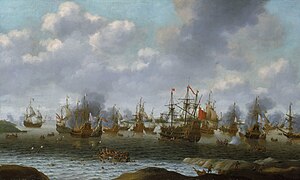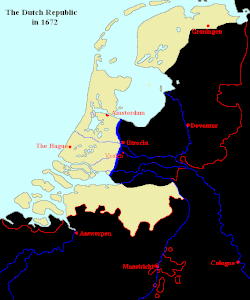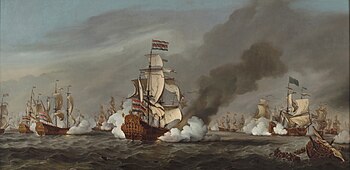Dutch Empire/Anglo-Dutch Wars
| “ | The rise of the Dutch Republic must ever be regarded as one of the leading events of modern times. | ” |
—John L. Motley | ||
First Anglo-Dutch War (1652-1654)
[edit | edit source]The trading rivalry between the Dutch Republic and England broke out into war in May of 1652. Maarten Tromp, commander of the Dutch Navy, was slow to dip his flag in his salute, an English ship fired warning shots, hitting a Dutch Ship. This led to the Battle of Goodwin Sands and the start of the First Anglo-Dutch War. One Dutch diplomat stated "The English are about to attack a mountain of gold; we are about to attack a mountain of iron." The war would be costly for both sides.

At the Battle of Plymouth, the English attempted to destroy the Dutch fleet, however they were beaten back, and pursued by Michiel de Ruyter. It was the beginning of a Dutch legend. Soon after the Battle of Plymouth, the English and Dutch fleets clashed again in the North Sea at the Battle of the Kentish Knock. The English routed the Dutch fleet commanded by Tromp, and mistakenly believing that the Dutch fleet was destroyed, did not pursue.
The English, very confident they had won the war, sent most of their fleet to the Mediterranean. The Dutch then launched a surprise attack on the remaining English Fleet in the North Sea, which gave control of the North Sea and the English Channel back to the Dutch. By spring, the English fleet had returned and defeated the Dutch at the Battle of Portland. Several days later, however, a small portion of each sides' fleets met in the Battle of Leghorn in Italy and the Dutch chased the English out of the Mediterranean. The English fleet won another major victory at the Battle of the Gabbard. The Dutch fleet was too weak to challenge the English and therefore a blockade was put on the Dutch Republic, which crippled the Dutch economy.
The Dutch broke the English blockade at the Battle of Scheveningen, but during the fight Tromp was killed. At this point, both sides were completely exhausted from war and signed the Treaty of Westminster (1654). The treaty failed to resolve the dispute between the two countries, and only set the stage for the next war.

Second Anglo-Dutch War (1665-1667)
[edit | edit source]The issues that started the First-Anglo Dutch War, still remained and were not resolved by the peace treaty. The English still wanted the Dutch trading routes, and to end the world domination of Dutch trade. As tensions increased the English seized the Dutch colony of New Netherland and took many Dutch trading posts on the coast of Africa. The Dutch quickly responded by sending Michiel de Ruyter to recapture their trading posts in Africa. After recapturing the trading posts, he sailed across the Atlantic, where the Dutch Fleet was attacked and forced to withdraw. Shortly after, on March 4, 1665, England declared war on the Dutch Republic.

In June of 1665 the two fleets met in the North Sea. This would result in the Battle of Lowestoft. The English routed the Dutch fleet, destroying 17 Dutch warships at a cost of only one of their own. Even to this day it is the worst defeat in Dutch Naval History. The next conflict between the two sides was a minor encounter in Norwegian Port. At the Battle of Vågen, the English attempted to seize a few Dutch merchant ships. However, the merchant ships were being escorted by war ships and the English attack was driven back.
In June of 1666, the Dutch fleet under the control of De Ruyter, was attacked by the English fleet in the North Sea at the Four Days Battle. It was one of the largest Naval engagements in history, lasting four days (hence the name). After four days of constant engagement, De Ruyter, seeing that he had inflicted considerable damage on the English fleet, ordered his fleet to withdraw. The English lost 10 ships, the Dutch 4.
Later that summer the two fleets would clash again at St. James Day Battle. De Ruyter as once again in control of the Dutch fleet, his goal was to attack the English fleet while it was anchored in the Medway. On his way there, he discovered an English fleet of 89 ships and pursued it. The battle was a clear English Victory, inflicting heavy casualties onto the Dutch, however, De Ruyter was able to withdraw losing only 2 ships, while the results could have been much worse.
The English quickly decided to attack while the Dutch fleet was unable to fight back due to the losses it received in the St. James Day Battle. English Rear-Admiral Robert Holmes, attacked a large fleet of Dutch merchant ships. The English were successful in setting fire to, and destroying, 150 of the merchant ships.

In June of 1667, the Dutch Fleet under De Ruyter, decided to launch a daring attack on the English fleet while it was still docked. De Ruyter ordered an attack on June 10. The Dutch fleet quickly captured the English forts, and defeated the English ships guarding the Medway. On June 13, the whole of the Thames side as far up as London was in a panic — some spread the rumor that the Dutch were launching a full scale invasion of the country. Many citizens fled, taking their possessions with them. On June 14 the Dutch fleet withdrew, but they had sunk 13 English Ships, and captured 2 ships. HMS Unity and HMS Royal Charles, pride and normal flagship of the English fleet, while total losses for the Dutch were eight spent fireships and about fifty casualties. The Battle is now called Raid on the Medway, it was a decisive Dutch victory and is considered the Greatest Naval Victory in Dutch History, and the worst Naval Defeat in English. Commenting on the defeat, Samuel Pepys, English Naval Administrator and member of Parliament, said "The Devil Shits Dutchmen".
After the raid on the Medway, the English fleet was crippled and England was forced to sue for peace. Pepys making another comment about the war, said "Thus in all things, in wisdom, courage, force, knowledge of our own streams, and success, the Dutch have the best of us, and do end the war with victory on their side". During negotiations, the English offered to return New Netherland if the Dutch would return Suriname (which they had seized in 1667). The Dutch declined. On July 31, 1667 the Treaty of Breda (1667) was signed. The Dutch were now at the zenith of their power.
Franco-Dutch War (1672-1678) and the Third-Anglo-Dutch War (1672-1674)
[edit | edit source]
France led a coalition including Münster and England. Louis XIV was annoyed by the Dutch refusal to cooperate in the destruction and division of the Spanish Netherlands. After making a secret agreement with England in 1672, France invaded the Dutch Republic. Today, 1672 is still remembered as Rampjaar in the Netherlands, which means "year of disasters". The French soon marched into the Heart of the Dutch Republic, taking Utrecht. To stop the French advance, the Dutch flooded the countryside (Dutch Water Line) which stopped the French advance. At this time, Prince William III of Orange is assumed to have had the leading Dutch politician Johan de Witt deposed and murdered and was acclaimed stadholder.
On the western front, where the Dutch had been attacked by Munster, the Dutch defeated Munster at the Siege of Groningen. After the Dutch victory the Dutch liberated some territory and drove Munster out of the country.
Meanwhile, the sea war with England was going much better for the Dutch than the land war. The Dutch, lead by De Ruyter, defeated the English and French fleets at the Battle of Solebay and Schooneveld. The French and English then came up with a plan to invade the Republic by Sea. However, after their fleet was defeated at the Battle of Texel, they were unable to land troops. The war was becoming very unpopular at home in England, thus, the English withdrew signing the Treaty of Westminster (1674). In the treaty the Dutch agreed to return New Orange (formerly New Netherland) to England, which they had seized in 1673.
In 1673 Spain joined the war on the side of the Dutch. De Ruyter sailed the Dutch Fleet into the Mediterranean to destroy the French naval supremacy there. The Dutch were victorious in the Battles of Stromboli and Mt. Etna (1676); however, Admiral de Ruyter was mortally wounded in the latter. Respect for De Ruyter extended far beyond the borders of the Republic. When his body was shipped home, the late Lieutenant-Admiral-General was saluted by cannon shots fired on the coasts of France, by the direct orders of the French King Louis XIV.
The War was not only in Europe, it extended to Canada. Jurriaen Aernoutsz, a navy captain from Curaçao, captured the French colony of Acadia in 1674. A Dutch fleet attacked, but failed to take Martinique 1674. In May 1676 Dutch Admiral Jacob Blinck took Cayenne and Tobago. The French would soon retake these possessions. In December 1676 French Vice-Admiral Jean d'Estrees retook Cayenne. The French also recaptured Tobago in 1677.

In Europe, the French had begun a slow withdrawal from the Republic. Negotiations began in 1676, and the Treaty of Nijmegen was signed in 1678. The war had been very costly for the Republic, but they had defended their land and kept all of their territory across the world.
Fourth Anglo-Dutch War (1781-1784)
[edit | edit source]Britain declared war before the Dutch could join a group of neutral countries sworn to mutual assistance. The direct cause of the war was the discovery of a secret trade treaty proposed by the city of Amsterdam to the Americans. The Dutch had not at all expected such a severe reaction; they had given the British a perfect pretext to reduce Dutch power even more. This Fourth Anglo-Dutch War (1780–1784) proved a disaster for the Netherlands, particularly economically.
Dutch naval power had been in decline since 1714. The Dutch navy, now having only twenty ships of the line, was no match for the British navy. Britain had already gained supremacy of the high seas over France long before, in the Seven Years' War. The Dutch fought a minor skirmish with the British at the Battle of Dogger Bank, but had to avoid any other fighting. The Dutch had already hastily embarked on a major shipbuilding project of 84 warships between 1777 and 1789. Due to all kinds of misfortune (storms, collisions, strandings), about a third of the Dutch fleet sank between 1782 and 1784. Coordination with its war allies, France and Spain, was poor. The new ships were not ready in time to prevent Britain from taking effective control of the Dutch colonies and making William V a puppet, only able to rule with Prussian military assistance in the Triple Alliance (1788). The Republic joined a cease fire between Britain and France in January 1783. The signing of the Treaty of Paris (1784) made Negapatnam, in India, a British colony. Ceylon, though taken, was nominally given back. The British gained the right of free trade with part of the Dutch East Indies.
